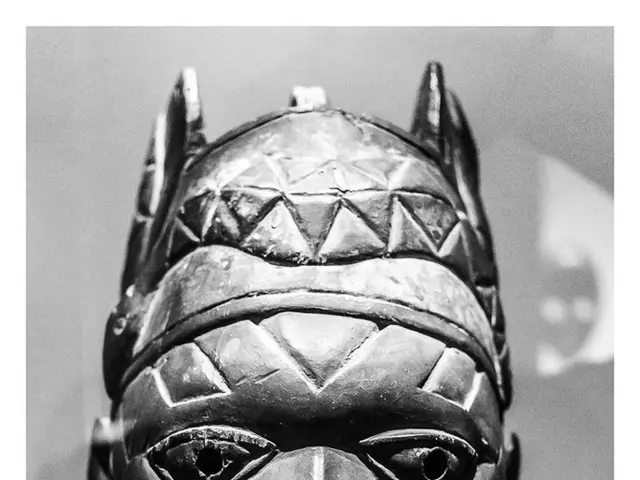Distinguishing Age Spots from Skin Cancer: Recognizing the Differences
Rewritten Article:
Yo, here's the dirty truth about those spots popping up on your skin as you're aging - you know, age spots, solar lentigines, or liver spots. These bad boys can look like some frightening forms of skin cancer, or even precancerous growths. But fret not, you don't need to visit a crypt or a mad scientist to figure out differences.
Both age spots and skin cancer tend to show up on areas exposed to the sun's rays, like your mug, hands, and shoulders. To understand the critical differences between them can help you determine when you need a professional's opinion. The difference can be summarized in texture, color, and placement.
This piece dives into the contrasts between age spots and skin cancer, along with the symptoms, diagnostics, and treatments for both conditions.
What's the skinny on age spots compared to skin cancer?
Yeah, sure, age spots and skin cancer can seem to be the same-oli' at first glance. However, unlike its cancerous cousin, age spots are absolutely harmless and ain't bothering nobody.
Age Spots
These suckers are called age spots, solar lentigines, or liver spots, and they're these tiny, darker patches that appear on your skin. They're generally flattened, smooth, and don't itch, crack, or feel funky. They crop up when your body pumps out extra melanin to protect your skin from the sun's UV rays, causing the skin to darken.
Age spots are more common on fair skin, but they can spring up on any complexion. You'll usually start seeing 'em as you age into middle age or older.
Skin Cancer
Skin cancer is the real deal – it's cancer, alright! Like age spots, skin cancer often appears on sun-soaked areas. This is due to damage inflicted on your skin by UV radiation from the sun or tanning beds.
Skin cancer happens when UV radiation or other factors bungle up skin cells, leading them to grow and multiply at an uncontrollable pace. Unlike age spots, skin cancer is dangerous and may spread to other parts of your body.
The three most common types of skin cancer are basal cell carcinoma, squamous cell carcinoma, and melanoma. Another wacky thing that might be mistaken for an age spot is actinic keratosis – that's a pre-cancerous growth caused by UV damage.
Isn't it kinky when age spots turn into cancer?
Nope, age spots can't mutate into cancer. However, actinic keratosis, which can look similar to age spots, is a precancerous growth that can develop into cancer if it's not treated. So keep an eye on any new or transforming marks on your skin and don't hesitate to yack it up with a healthcare professional when you see something suspicious.
Symptom comparisons
There are a ton of distinctions in symptoms between age spots and skin cancer that can help you recognize which condition is brewing.
Age spot symptoms
Age spots are:
- flat and smooth
- brown, yellow, or gray
- defined, with discernible edges
- a few millimeters to centimeters in size
- found on sun-exposed areas like:
- your face
- hands
- shoulders
- feet
- arms
- back
Age spots might dim in winter but come out swinging in summer when your skin's exposed to more sun.
Skin cancer symptoms
Skin cancer symptoms can vary based on many factors, like the type of skin cancer. Here's what to look out for when a skin growth might be cancerous:
- misshapen, asymmetrical, or jagged edges
- changes in color, size, or shape
- multiple colors on the same spot
- pink, red, purple, blue, black, or brown coloring
- elevated, red patches
- pale or yellow, scar-like patches
- tenderness, itching, oozing, or bleeding
- crusty or scaly patches
- raised edges that sink in the middle
Signs of actinic keratosis include:
- rough, scaly patches
- red, gray, pink, or skin-colored patches
- flat, scaly patches resembling age spots
- clusters of scaly, rough bumps like acne
- patches on the lips
- horn-like growths
When to call in a doc
In general, if you see any skin abnormalities that don't feel like you, reach out to a doctor. Monitoring new marks on your skin and consulting a doc if there are potential signs of skin cancer can help with early detection, making treatment easier and boosting health outcomes.
Get yourself to a doctor if a mark on your skin:
- changes in color, shape, size, or location
- looks different from other marks on your skin
- itches, crusts, scabs, or refuses to heal within four weeks
Diagnostics
To identify age spots, your doctor or dermatologist will perform a physical examination of the spot and assess its appearance, texture, and placement. If they're unsure after examining it, they might perform a biopsy to test for other conditions like skin cancer or actinic keratosis.
The results of a skin biopsy reveal whether you have skin cancer or another skin condition.
Treatment
Ain't nothing to worry about age spots; they're harmless. But some folks might wanna camouflage them for cosmetic reasons.
Possible treatments for age spots include creams, lotions, and potions that may gradually reduce their appearance over time. Many of these can be purchased without a prescription, and your dermatologist can suggest the most effective treatments.
Cosmetic procedures to minimize the appearance of age spots include:
- laser treatments
- cryosurgery
- microdermabrasion
- chemical peels
Skin cancer treatment
Treatments for skin cancer vary based on the type and stage of cancer, along with individual circumstances. If possible, your doc will surgically excise basal cell and squamous cell cancers. However, sometimes a cancer's position prevents surgical removal.
Treatments for skin cancer and actinic keratosis can include:
- topical therapies
- radiation therapy
- chemotherapy
- immunotherapy
- systemic medication
The dirty wrap-up
Age spots, skin cancer, and actinic keratosis can look the same, but there are ways to distinguish them. Checking for details such as size, shape, texture, and color can help you know when to consult a healthcare professional.
Remember to regularly inspect your skin and chat it up with a dermatologist when you notice unusual changes. Early detection can make skin cancer treatment a breeze and improve health outcomes. You can choose to treat age spots to conceal their appearance. But hey, remember, age spots are a natural part of aging, so try not to stress about 'em too much!
- Both oncology and dermatology are medical fields that specialize in understanding and treating cancer, including melanoma and other skin cancers like skin cancer, and skin conditions such as age spots.
- As seniors age, they may develop certain skin conditions such as age spots or skin cancer, making it important for them to pay attention to changes in their health-and-wellness and skin-care.
- The science of oncology involves researching and developing treatments for various types of cancer, including skin cancer, while dermatology focuses on understanding and addressing skin-related medical conditions, such as age spots.
- A major difference between age spots and skin cancer lies in texture, color, and placement – age spots are often flat, smooth, and don't itch, crack, or feel funky, whereas skin cancer may present as misshapen, asymmetrical, or jagged growths with multiple colors, changes in size or shape, and other symptoms.
- Paying attention to one's skin and seeking medical advice when noticing any potential signs of skin cancer can help with early detection, which is a crucial aspect of health-and-wellness and skin-care.







